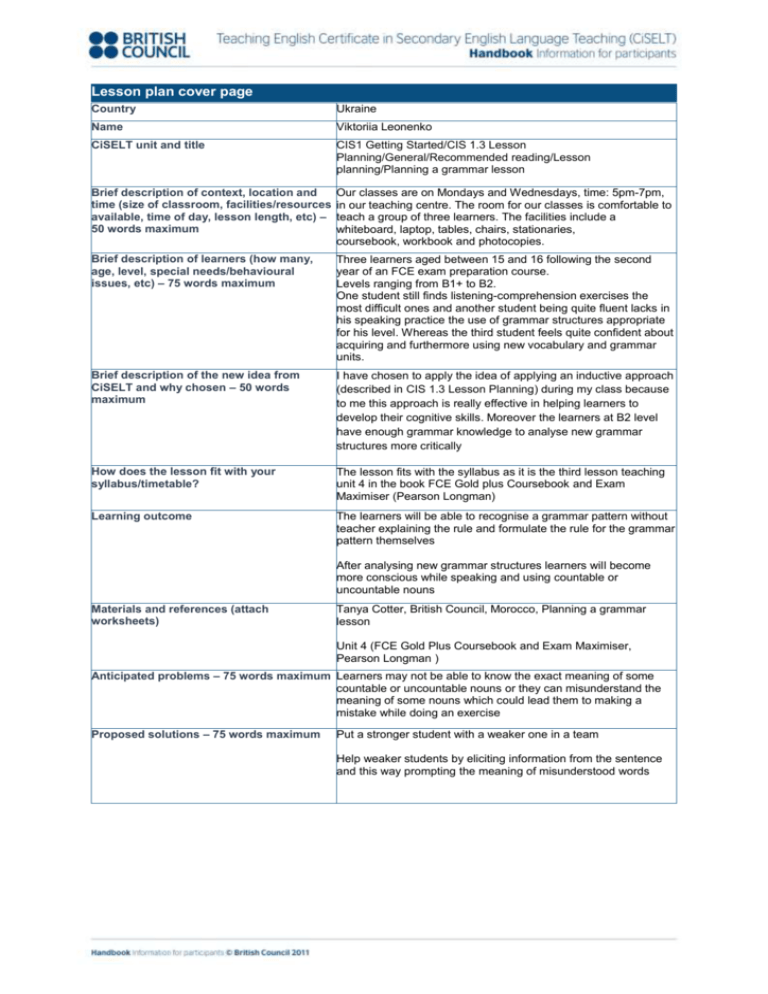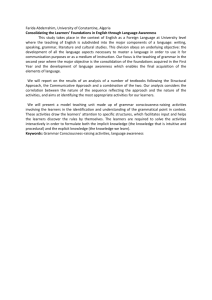
Lesson plan cover page
Country
Ukraine
Name
Viktoriia Leonenko
CiSELT unit and title
CIS1 Getting Started/CIS 1.3 Lesson
Planning/General/Recommended reading/Lesson
planning/Planning a grammar lesson
Brief description of context, location and
time (size of classroom, facilities/resources
available, time of day, lesson length, etc) –
50 words maximum
Our classes are on Mondays and Wednesdays, time: 5pm-7pm,
in our teaching centre. The room for our classes is comfortable to
teach a group of three learners. The facilities include a
whiteboard, laptop, tables, chairs, stationaries,
coursebook, workbook and photocopies.
Brief description of learners (how many,
age, level, special needs/behavioural
issues, etc) – 75 words maximum
Three learners aged between 15 and 16 following the second
year of an FCE exam preparation course.
Levels ranging from B1+ to B2.
One student still finds listening-comprehension exercises the
most difficult ones and another student being quite fluent lacks in
his speaking practice the use of grammar structures appropriate
for his level. Whereas the third student feels quite confident about
acquiring and furthermore using new vocabulary and grammar
units.
Brief description of the new idea from
CiSELT and why chosen – 50 words
maximum
I have chosen to apply the idea of applying an inductive approach
(described in CIS 1.3 Lesson Planning) during my class because
to me this approach is really effective in helping learners to
develop their cognitive skills. Moreover the learners at B2 level
have enough grammar knowledge to analyse new grammar
structures more critically
How does the lesson fit with your
syllabus/timetable?
The lesson fits with the syllabus as it is the third lesson teaching
unit 4 in the book FCE Gold plus Coursebook and Exam
Maximiser (Pearson Longman)
Learning outcome
The learners will be able to recognise a grammar pattern without
teacher explaining the rule and formulate the rule for the grammar
pattern themselves
After analysing new grammar structures learners will become
more conscious while speaking and using countable or
uncountable nouns
Materials and references (attach
worksheets)
Tanya Cotter, British Council, Morocco, Planning a grammar
lesson
Unit 4 (FCE Gold Plus Coursebook and Exam Maximiser,
Pearson Longman )
Anticipated problems – 75 words maximum Learners may not be able to know the exact meaning of some
countable or uncountable nouns or they can misunderstand the
meaning of some nouns which could lead them to making a
mistake while doing an exercise
Proposed solutions – 75 words maximum
Put a stronger student with a weaker one in a team
Help weaker students by eliciting information from the sentence
and this way prompting the meaning of misunderstood words
Lesson procedure
Time
Teacher activity
3 min
Greet the learners and ask them Learners greet each other and T-S, S-S
about how their day was
the teacher and talk about their
day
To warm up and get
learners to think in
English
10min
Ask the learners if they had any Learners say what answers they T-S
questions about homework
chose and why
(reading a text about a chef and
doing multiple-choice questions
task in FCE Gold exam
Maximiser unit 4 pp34-35)
Put learners into 2 teams with 2 Learners do Ex 2 p46 (FCE Gold S-S, S-S
learners in one team and a
Plus Coursebook) while
teacher and a third learner in
differentiating between
another team
countable and uncountable
Give each team 3 sentences out nouns
of a cut into separate sentences Then learners analyse what
Ex2 p46 (FCE Gold Plus
helped them to understand that
Coursebook) - (see attached)- this or that noun is
and explain to learners that this countable/uncountable based on
time after doing the exercise
the context of sentences and
they’ll try to formulate grammar thus formulate grammar rules as
rules themselves
for the use of countable and
uncountable nouns
Ask learners to read Ex 4 p46 Learners read and explain why S
and say if sentences are true or sentences are true or false
false about them and why
about them
Teacher monitors, prompts and
corrects where necessary
To activate vocabulary
about food, cooking
which leads to the talk
about
countable/uncountable
nouns generally
To develop learners
analytical skills how to
understand and use
grammar structures
based on the context of
sentences
Ask learners to put the
Learners put the highlighted
S-S-S
highlighted expressions of
expressions of quantity into the
quantity into the correct column correct column in the table
in the table
Learners do Ex 1 p35
Give learners a copy with Ex
(Exam Maximiser)
1p35(Exam Maximiser) – (see Learners check each others’
attached)- as a diagnostic test to tests and compare with the right
see what learners understood answers from the teacher
and then ask learners to
exchange tests and check each
others’ tests
Then teacher gives learners the
right answers and learners
compare their results
Ask learners to think about the Learners discuss in a group of 3 S-S-S
importance of water in our life what they know about
Ask learners to work as a group importance of water and amount
of 3 and decide on how much needed daily
water is vital daily and decide on Learners work out a list of 3
a list of 3 most important
advantages of drinking water
advantages of drinking water
daily
Ask learners to skim Use of
Learners skim the text to figure S
English open cloze text –(see out what the text is about
attached)-to find out the main 1 nominated learner reports
idea of the text and then
back
nominate 1 learner to report
back
Pre-train learners names of
Learners write out their
S
parts of speech
expectations of parts of speech
Ask learners to identify what
Learners check their answers
T-S-S
parts of speech is expected in with answers given by the
each gap
teacher
Check answers with learners
To develop learners
ability to differentiate
between the use of
expressions of quantity
with countable and
uncountable nouns
To develop peer
correction skills
20min
7min
15min
10min
5min
10min
Learner activity
Interaction
Stage aim
To develop learners
abilities to differentiate
between the use of
expressions of quantity
Develop learners’ freer
speaking practice skills
Activate vocabulary to
be found in further
reading
To develop learners’
ability to skim a text for
a general idea
To develop learners’
ability to differentiate
between parts of
speech and raise
awareness about parts
of speech
15min
Ask learners to do open cloze
activity Use of English part 2 p
47
Ask learners to explain their
choice
Learners do open cloze activity S
and explain their choice of parts
of speech
Develop learners’ exam
Use of English part 2
skills
Develop learners’ ability
to analyse
5min
Ask learners to listen to
Learners listen to recording and S
recording and complete gaps
complete gaps with missing
with missing words/useful
words individually
phrases for talking about
advantages and disadvantages
To develop learners’
listening for details skills
10min
Ask learners to look at p181(see attached)- and do the
speaking task, to debate, to
discuss and finally to agree on
one option
Teacher takes notes and
comments after learners finish
debating
Explain to learners the structure
of writing task (article) and ask
learners to prepare an article as
home task
Learners discuss in a group of S-S-S
three, share their opinions and
decide on one option acceptable
for all three learners
To develop learners’
exam skills (speaking
part 3)
Learners get to know with the
structure of an article
To develop learners’
exam skills (writing an
article)
10min
T-S-S
Reflection
What went well? Why?
All in all learners achieved what was planned for them. The
inductive approach worked really effectively though such a way of
(refer to the learners, learning outcomes
dealing with grammar and grammar rules formulating by learners
and stage aims, lesson procedures, tasks / themselves was quite new for learners.
activities and materials)
And one more thing that turned out to be quite useful free
speaking practice for learners though it wasn’t for them the first
150-180 words
time dealing with such tasks namely exam speaking part 3
Learners were faced with quite a challenge of brainstorming the
biggest number of advantages and having to agree on just one
option as required by the exam task.
I think I could say that I was really proud of the fact that learners
having faced difficulties while doing rather an uneasy and unusual
task of formulating grammar rules themselves still enjoyed it thus
making the lesson more learner- centred
The debates on importance of daily consumption of water and
dealing with exam speaking part 3 proved to be the most
engaging for all the learners as the topic was interesting and all
the learners had something to say
172words
What didn’t go well? Why?
The learners found it difficult to agree on just 1 option as required
by speaking task3 so they spent more time than required and it
(refer to the learners, learning outcomes
also resulted in almost no time left to discuss the mistakes made
and stage aims, lesson procedures, tasks / by students during the speaking task
activities and materials)
But anyway learners managed to cover everything planned for
them for the lesson
150-180 words
What changes will I make next time? Why? If I could teach the same lesson again, I would bring a minute
glass or a timer to indicate physically for learners how much time
150-180 words
left for their exam speaking task so that this way learners will be
obliged to think, speak faster and agree on one option faster
I believe that trying out new approaches in teaching is mutually
beneficial for learners as they can have more variety during
lessons and it means for teachers continuous enthusiasm in the
subject learnt on behalf of students and beneficial for teachers too
as different approaches/techniques help to understand learners,
their styles of studying better to make the learning process more
personalized and thus more effective
Result
Moderator’s comments, advice and suggestions
Moderator:








